June/July 2019
Our Own Private Tanzania
Where we come upon a somewhat chaotic but also fascinating land
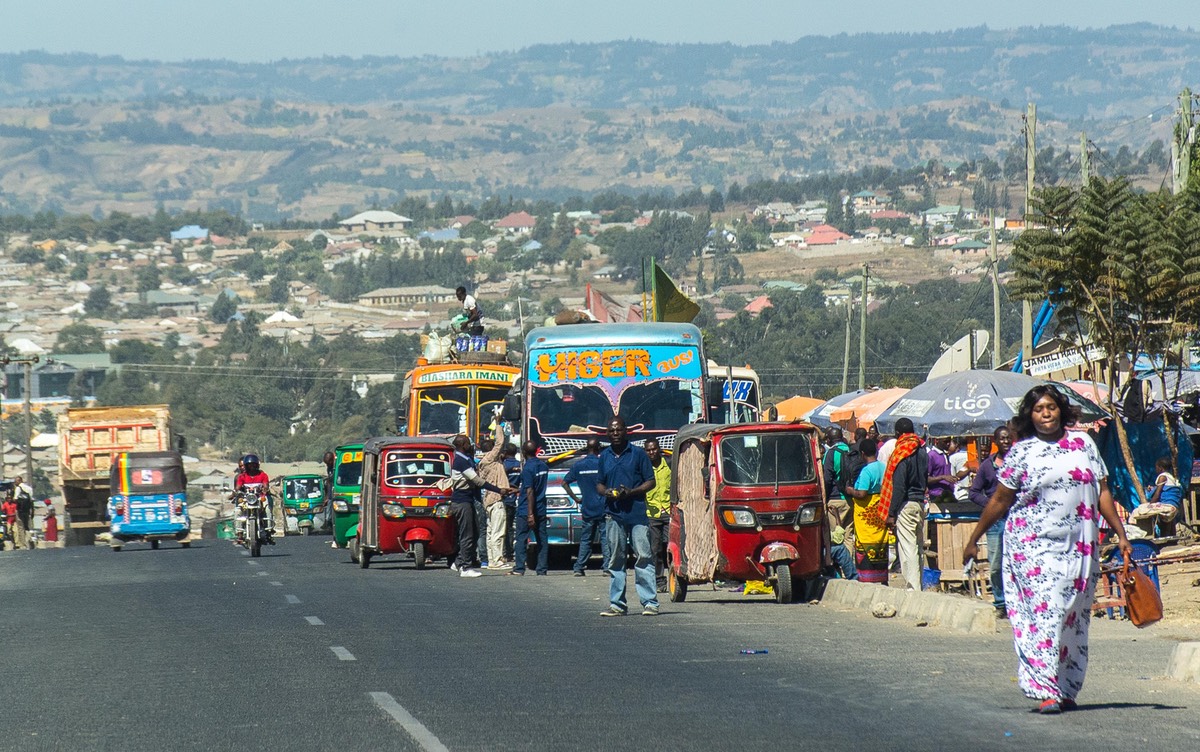
There we were, at the upper end of Zambia, heading for the border with Tanzania, climbing this small, really bad road. Big sharp rocks to fill in large deep holes. Ultimately beyond our comfort level. This is where we looked at each other and admitted this just wasn’t what we wanted to be doing. And we decided to make a major course change, which resulted in a switch in where we would cross the border.
When you choose not to use the small and quiet (although horrid) road for moving between these two countries, you are left with only the notorious, very major and difficult crossing at Tunduma, a few hours further south and east. Tanzania was to be our seventh new country in Africa, and we already knew it would be hard. It is a major bottleneck for all truck traffic between Dar es Salaam and Cape Town. Also, a new border crossing area had recently been built that — supposedly — combines in a single building all the official desks you have to clear going in both directions, but there is no signage, no place to ask questions, they aren’t actually all in the same building and the road through the area is in awful condition. Our favorite nightmare!
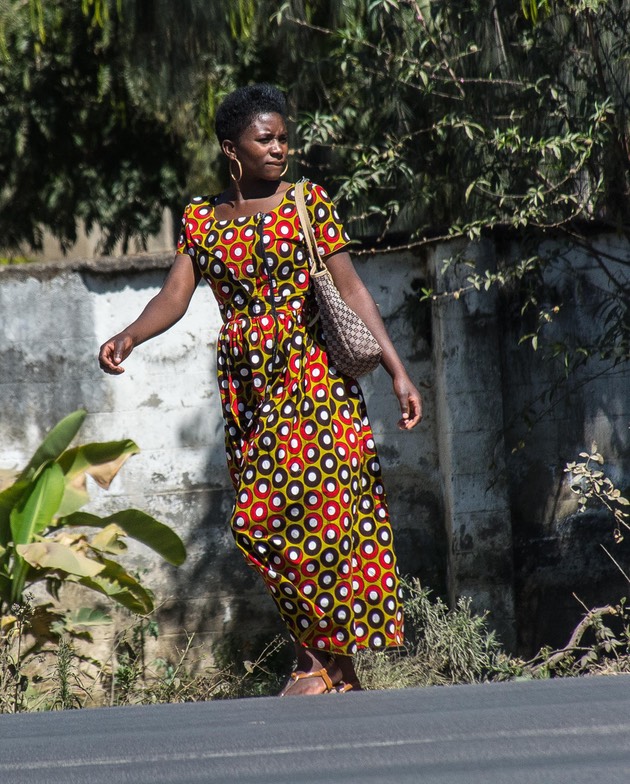
Tunduma is known for its chaos and pandemonium, the sheer volume of the truck traffic, the strong suggestion that you really do need a helper to get stuff sorted out, and the length of time that it’s going to take. We can vouch for every bit of that — and more.
As it happened, we had problems on both sides of the border. In Tanzania it was mostly just plain old inefficiency, an African staple of life. But before we could even leave Zambia, the staff had to come to a satisfactory resolution of the fact that when we had entered the country, paying our money and getting our visas properly entered in our passports — we were not given written receipts for the payment. (It being our first crossing where we had to pay for the visas, we hadn’t realized we were supposed to get receipts. Duh!) So they got supervisors, and made phone calls and eventually got around the problem by writing a lengthy report on an interrogation of us as to the suspicious lack of said receipts. No rubber hoses or harsh lighting; in fact everyone was very nice about it. But still we couldn’t help feeling that it was all somehow our fault. Whew!
In the end we survived of course. The crossing at Tunduma is made more difficult by the lack of any sort of nearby camp site on the Zambian side. This meant that we had to press ahead with crossing the border even though we would have rather put it off until morning. We arrived after lunch with no choice but to continue on and so we did, hoping for the best. Hah! Four hours later, exhausted, and with Rick still under the weather, we limped out of the border compound into the new country. It was 5:30 at night and getting dark.
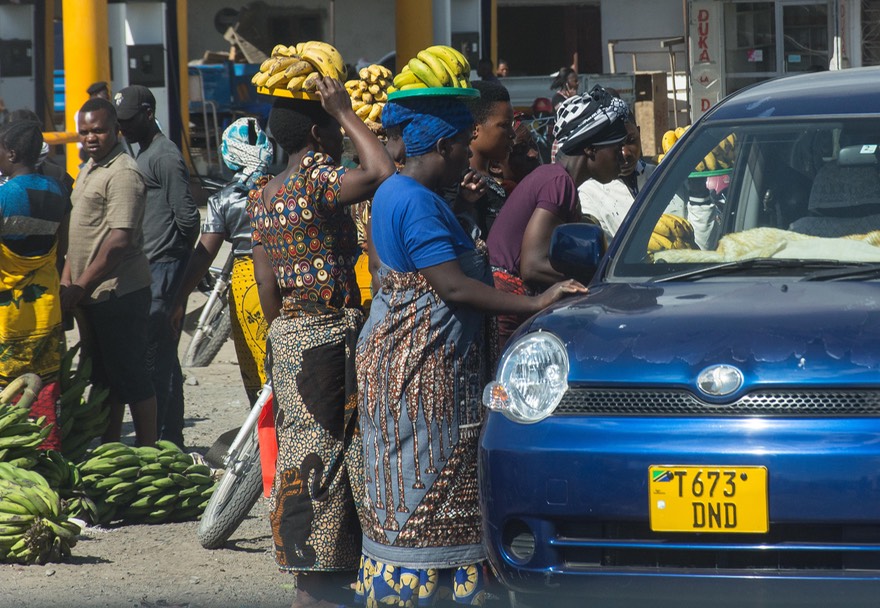
We cruised through town a bit, looking for a hotel or lodge that might be interested in us, but Tunduma is a less than charming spot. As on the Zambia side, we had no known camp or lodge to head for close enough to reach before dark. Finally, we decided to pull into a very clean and tidy Puma fuel station that was open all night. They were quite welcoming, introduced us to the security guards, found a nice spot for us, and said they’d see us in the morning. We happily collapsed. We were right on the road out of town, and wondered if it would be noisy all night. Not at all, actually. We were in the midst of trucks, but their drivers were asleep even before we were, and not a single one departed before about 9:00 am. And no rigs passed by out front in the dark. Best damn fuel station we’ve ever stayed at!
We heard the call to evening prayer, saw a few folks in Arabic robes and some women wearing muslim head scarves. Less English was spoken here (or understood), and we knew Swahili was the first language for all Tanzanians. It had been easy to forget, what with all the recent plan changes, that we were now in East Africa, and many things would be different. As the days went by, we noticed that the women in particular were wearing much brighter, more dramatic clothes, and the markets were both more vibrant and more varied. It was a lovely change.
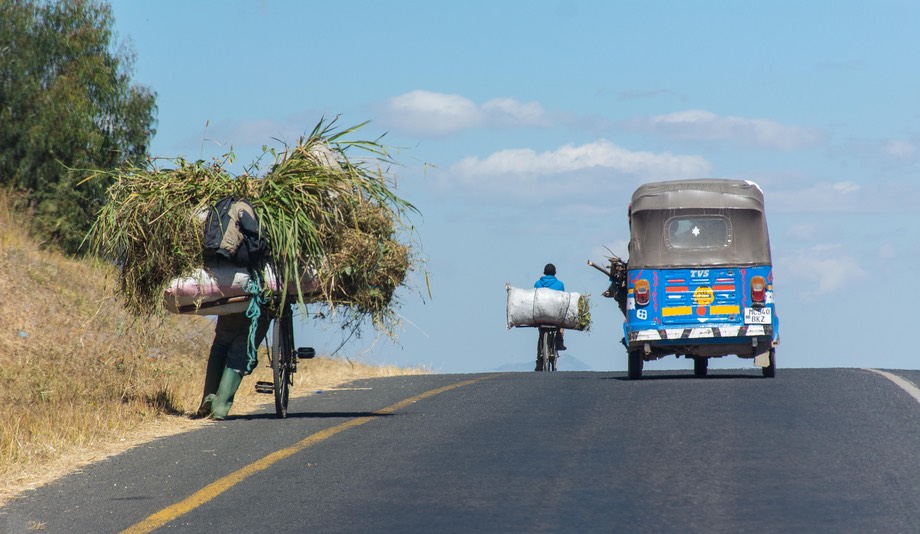
Something else that was new was the presence of tuk-tuks, three wheeled scooters used as taxis in many countries, and the first we’ve seen since we left Central America 11 years ago! We were delighted! They are lively, wildly decorated, zip around ignoring the traffic signals, beep-beep at everyone and everything — perky and fun. They were joined by multitudes of motorbikes. In Zambia, it was mostly bicycles we saw on the roads. Now? Between them, the tuk-tuks and motorbikes had taken over everywhere! Tanzania was immediately a much more motorized society.
Not only the tuk-tuks and motorbikes, but the entire ambience of Tanzania just assaulted our senses. It was so, so different from what we’ve become accustomed to during our time in Africa. The energy, the color, the general chaos of the traffic and the huge numbers of people out walking and working and just going about their everyday lives took us both right back to Guatemala or Honduras — it was great.
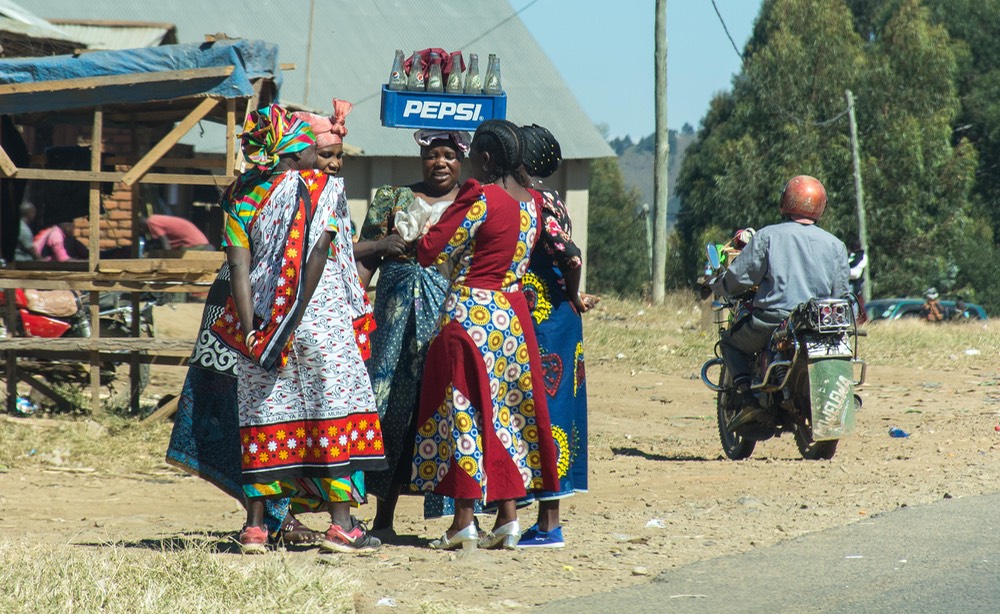
They even have Chicken Buses — brightly painted buses of varying sizes with religious sayings and lots of gold and silver glitter spread about. We’d only crossed a line on a map, from Southern Africa into East Africa, but it was like we’d changed continents! Wow!
Now don’t misunderstand, this change carries with it a whole mixed bag of things, some good and some not so good. We love the color and the sense of energy, but the chaos comes with a price, particularly at twilight as you are entering a brand new and challenging country and not knowing where you’ll be able to spend the night. We were both excited and a little worried at what we may have gotten ourselves into.
After a good night’s sleep, everything seemed much more settled. Rick looked around the Puma station and noticed that there was a tire repair place off to one side. We rolled over, handed them a tire that had been going soft for several days, and had them take a look. The upshot turned out to be a wire that had penetrated the tire, and they made a patch. We’ll see if that does the trick, but we drove off enjoying a sense of at least making some progress on addressing our issues.
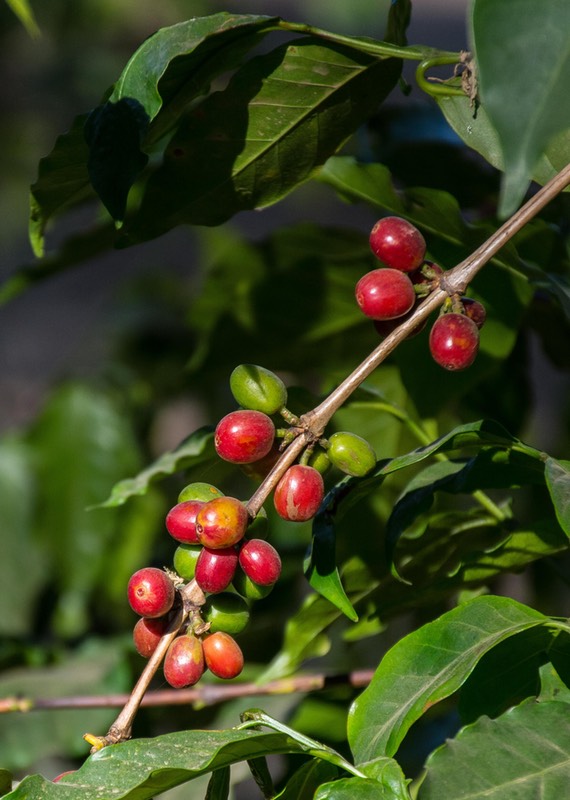
Feeling much better about things, we hit the road. We were heading towards Mbeya, the nearest city up the road; roughly a hundred kilometers from the border. It is easily the biggest city in southern Tanzania and our best bet for shopping and truck repair opportunities. Before we reached the city though, we wanted to head off to a spot that had been strongly recommended (thanks, Patti and Bill!) — the Utengule Coffee Plantation and Lodge. Arriving, we quickly realized we must have died and gone to heaven. It is indeed a lovely spot and is well known for absolutely first rate hospitality. The entire staff was just so gracious to us; it was a quite wonderful experience.
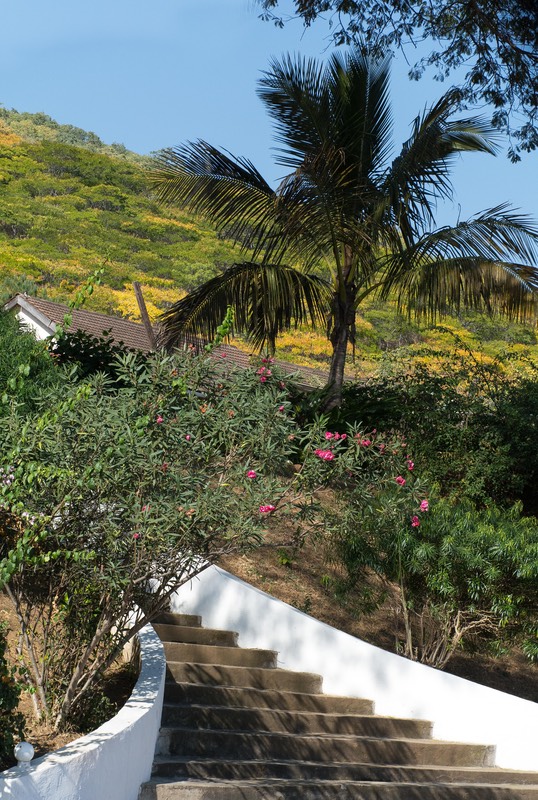
The Utengule Coffee Plantation has been in business for just about a hundred years now, and they sure do know the business of making coffee. The land sits at around 1800 meters in elevation, and they grow incredible arabica coffee here — which they happily share with you, sell to you, take you on tours to learn about growing it, and introduce you to the people who do the work. And then there’s the Lodge, a lovely old comfortable place to relax, swim in the pool, eat good food from their garden, and prepare yourself for what’s next in your life. Oh, and they bake their own bread and grow as many of their own veggies as they can. It seemed to be just what the doctor ordered for us in our somewhat depleted state.
We had a nice open grassy area to park on, and the restaurant was just up the hill, reached by climbing a set of rather strenuous stairs. As we’d been warned, it would be easy to stay forever but we reluctantly limited ourselves to a delightful five-day layover. We made plans for what was next, rested and slept well, and baked banana muffins. The one small disaster was that Rick’s knee, which had been giving him increasing trouble, did not take kindly to those stairs. For the moment, that just meant Kathy took the plantation tour by herself, and that she got to decide on the the pizza we ordered from the kitchen for lunch one day. No big deal.
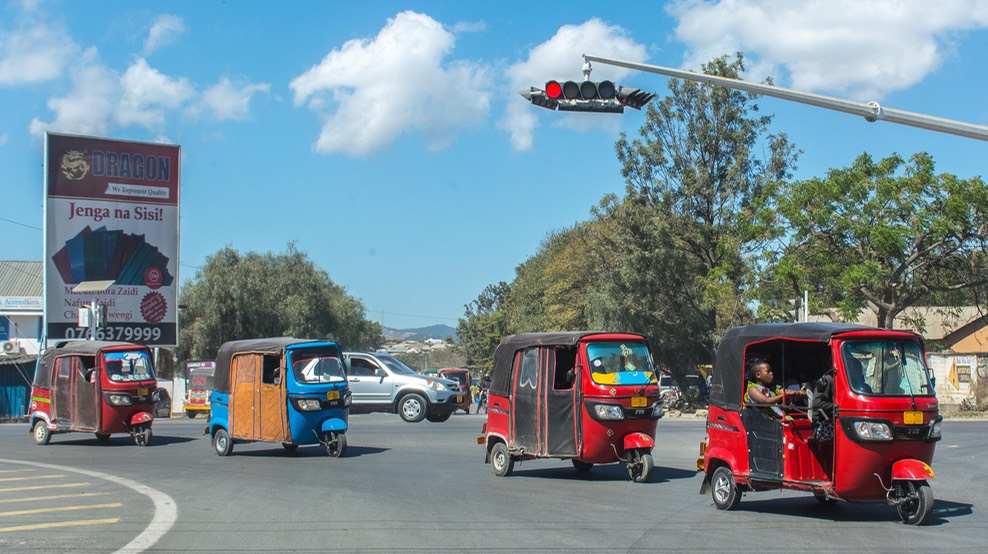
So after our lovely rest, off we limped (pun intended) on to Mbeya. And enjoyed ourselves in the big city. We were getting pretty low on food, but had gotten some suggestions at the coffee lodge as to where we might be able to do some small amounts of grocery shopping. There would be nothing in town in the way of a supermarket (in Tanzania you have to get all the way to Dar es Salaam over on the coast before anything like that shows up), but little mini-markets were scattered around, and we should start there. Also, there is a nice fruit and vegetable market in Mbeya; Kathy was going to try her hand at buying fresh produce on the street. The city market was major enough that the sellers should be able to handle the large bills that are all we ever get out of an ATM, regardless of what country we’re in. The lack of change had hampered us until now.
And we are very happy to report that on the food front, we did amazingly well. A first warning, if you are trying to find things in this town — Mbeya does not have any street signs, at least none we could find! No help from our GPS map either, no street names at all. At the coffee Lodge we had been given a couple of places to look for, and told we would find them on Magorofani Street. Hah!!! Where? What? No chance. But we asked at the open market and found the first store on our list, then ran into someone there who knew the other ones we were looking for and offered up some simple directions, and after a certain amount of circling the city that worked too.
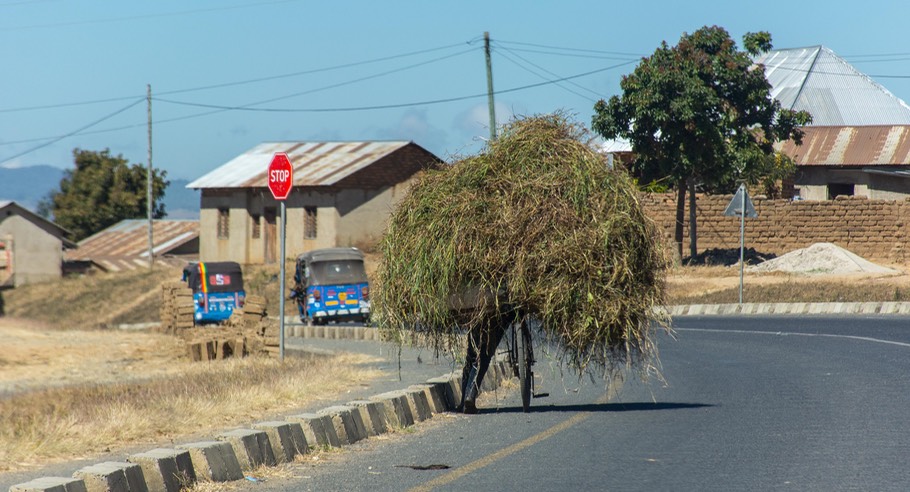
So — we scored some UHT milk, some decent cereal (Kellogg’s Crunchy Nut, not seen in ten months in Africa — Rick grabbed 4 boxes), some bread rolls, local potato chips, a block of cheddar cheese with all the info written in Swahili — and some ice cream. If desired, I could also have bought several brands of catsup and mango chutney, to give you some idea of what’s out there. Very cool and lots of fun.
But the fresh market was the best adventure of the day. We stopped, I got out, and at least 10 different people said hello and how can we help. I walked and looked and sampled. I talked to little old ladies (“Grandmom”) — who spoke no words I could understand, of course, and all the women and men who wanted to sell me their produce.
There was one beautiful and exotic (possibly) Indian woman who had open baskets of rice and flour and beans and dried peas, among other things. She and I talked, and she sold me some fine white rice. I saw that she had flour sitting out in a huge bowl; I asked about it, and she said it was maize. Not what I wanted.
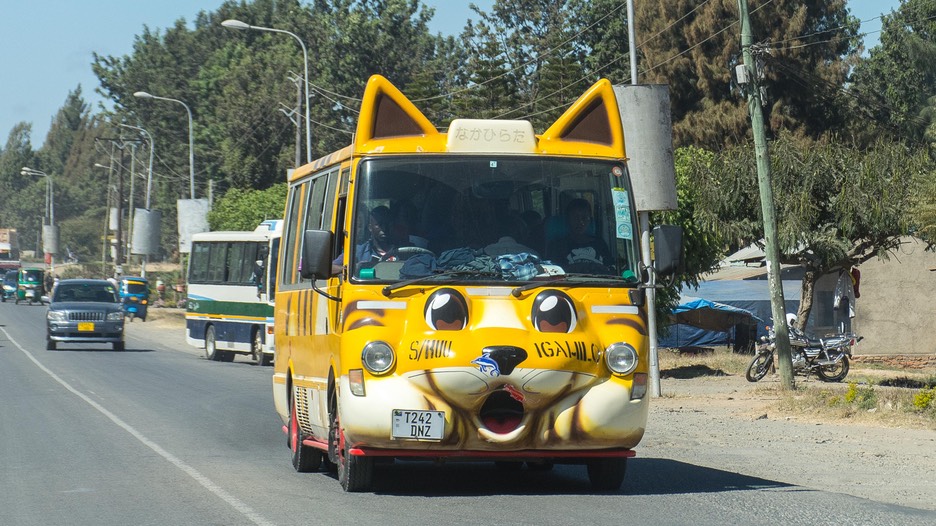
Then another lady came up and said she had flour — flour from wheat. She had a little store beside the market. I went with her and she poured a half-kilo of flour into a paper sack — she had a stack of them and they were made from old chinese newspapers that someone had fashioned into bags. It was so totally cool.
I had only large bills, and didn’t know how that was going to work out. Two people took charge, each accepting money from me (10,000 Tanzanian schillings each bill, worth maybe $4.25) and taking some for themselves for what they’d sold me, then each passing out the remainder to part of the crowd. I watched very carefully, asked each person I’d bought from if they’d gotten their share, and felt it was all being handled properly. When I left I had delicious carrots, lettuce, apples, pineapple, oranges, tomatoes, and bananas, plus peas, flour and rice. Such a great experience. My only frustration was that Rick couldn’t climb the steps up to join me, and so he couldn’t take any pictures of their beautiful faces.
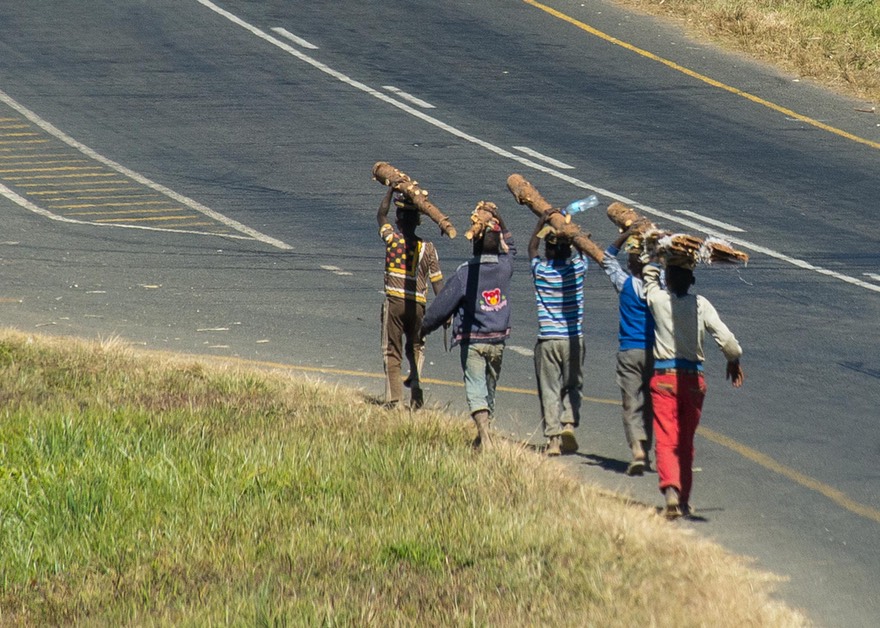
Our other project for Mbeya was to try to find a place that could tackle the coolant leak problem. We were successful on this front as well. As this is written, two weeks after the repair, everything seems to be holding, and hopes are high. As is the norm when traveling, we stopped to ask at a likely looking place with a sign declaring Diesel Service. They couldn’t help, but told us to go see Mr. Benny at Highland Motors. We did and he took very good care of us, setting to work right away and letting Rick explain what he wanted done and supervise the work.
Long story short for those interested, the leak was from a connection to the heater core. This should have been fairly simple to fix, but on the Silverado, GM uses a special plastic quick disconnect fitting at this location, and such a piece was never going to be found anywhere in Africa — where the Silverado was never sold and where GM no longer has a presence. Hence the problem.
So what the mechanic did, with Rick leaning over his shoulder and Mr. Benny stopping by to translate from time to time — you know how it is with that pesky English/Swahili interface — was to cut and paste (in a manner of speaking) a couple of hoses together in order to simply bypass the heater core altogether. The mechanic worked slowly and carefully, and at times was really pleased that Rick was able to provide some tools to supplement what the fellow had on hand. It was a fun interaction for Rick and a big help to have a young, agile, willing helper to do the physical part while Rick provided guidance and advice as to what he wanted done. Total cost of the project after about two hours work plus permission for us to stay overnight in the shop’s lot; just a bit over $20 US.
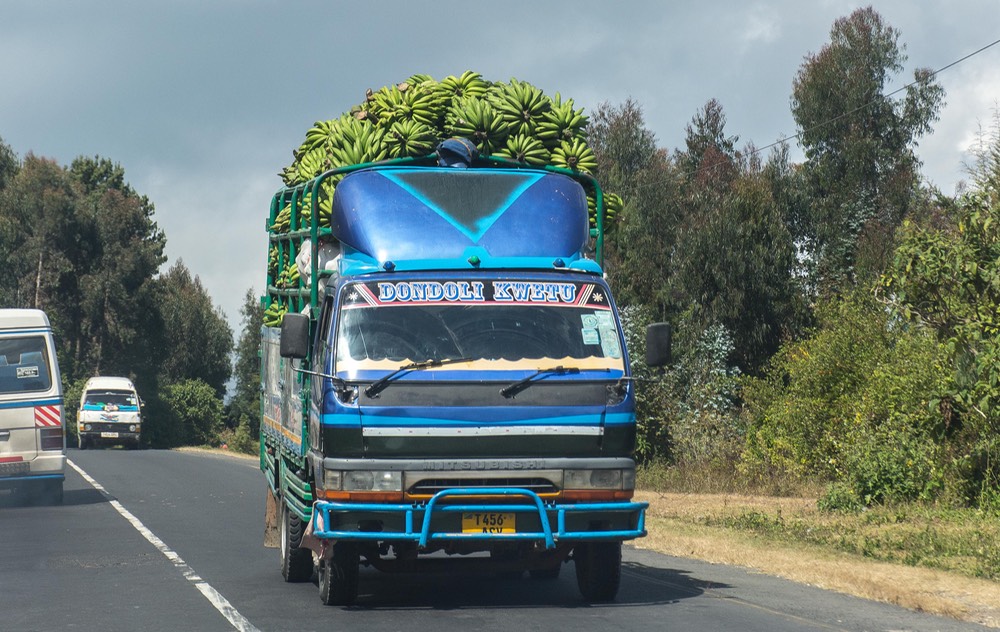
The repair looks good, isn’t leaking and we think it will do the trick for as long as we need it to. Temperatures in Africa, even in the winter, are not often low enough to have anyone looking for more heat, so we think we’ll be fine for as long as we’re here. For anyone wondering, this makes Tanzania the twenty-third country where we’ve had the Tiger serviced or worked on. How ‘bout that?
Finally ready to leave town the next day, our plan was to begin gently working our way south toward the Songwe River border crossing into Malawi. We had only been given 14-day visas for Tanzania, so we needed to either get those visas extended, or move on.
Time for an explanation as to why we weren’t going to spend more time here. It’s really pretty simple and boils down to just two things: high costs and bad roads. Similar to what we talked about in Botswana, but even more so here, the popularity of large-scale package tourism has exploded in recent years and the costs of seeing the country’s well known and highly regarded animal parks and natural sites has done the same. Large numbers of tourists fly in to go on Safari; the infrastructure to meet their needs in terms of lodges, buses, guides, helicopter and airplane flights, etc. has blossomed to cater to them.
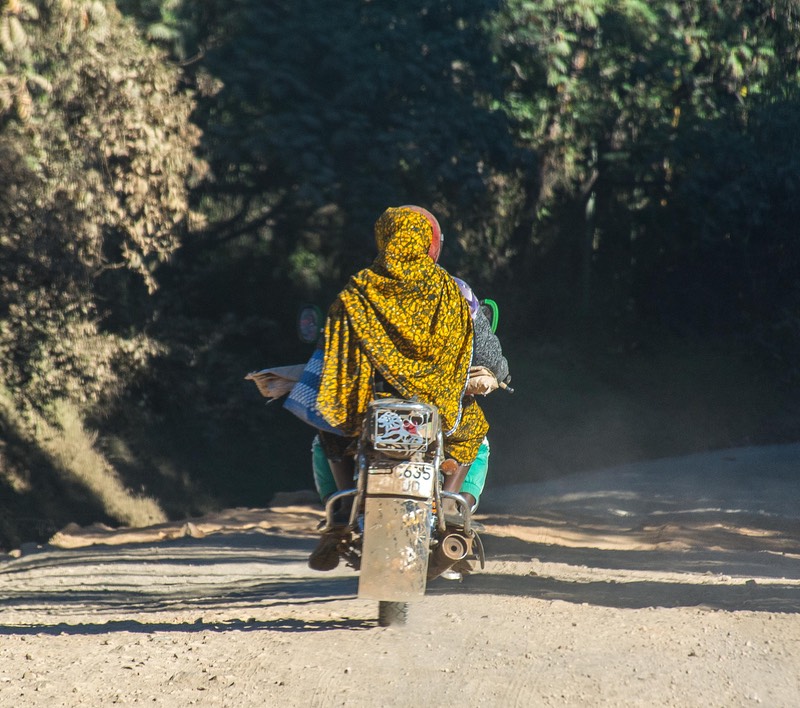
As a result the individual overland traveler is left struggling with huge costs, terrible roads filled with speeding safari trucks, and an inability to enjoy the views they’ve come to see. It is unfortunate, but it is the reality. So, much as we’d like to see the Serengeti, Mt Kilimanjaro and the Ngorongoro Crater, these were never going to be in the cards. For us, Tanzania had always been considered mostly a pass-through country on our way to Kenya and the countries surrounding Lake Victoria and then on the path south again. Once we decided not to continue further north, there were relatively few spots in Tanzania we wanted to try and reach.
The exception to this rather bleak scenario is the part of the country we’ve chosen to visit, the Southern Highlands. These are found in the southwestern part of Tanzania bordering Zambia and Malawi, and are therefore situated in just the area we’d be driving through anyway. This is a lovely region of varying elevation containing coffee, tea and banana plantations as well as extensive farming of corn, potatoes, and who knows what other crops. The soil is rich, the land is attractive and the people have proven themselves to be welcoming, with smiles and waves everywhere we turn. Part of this area lies in Kutulo NP, and that’s going to be our target.
The border with Malawi is less than 150 kilometers south of Mbeya, and after finishing all our chores we would be leaving town in that direction. First though, before leaving the Mbeya area, we wanted to go north just a bit to climb up to a spot called the World’s End Viewpoint at an elevation of over 2400 meters. This turned out to be not only a pretty drive on a good road, but also served as an excellent trial run for our coolant hose repair. We climbed six hundred meters (2000 feet) up a steady grade with no difficulty at all. It proved to be a bit too hazy at mid-day to enjoy much of a view out over the plains, but it made for a nice lunch stop before heading back to the city and on out the other side.
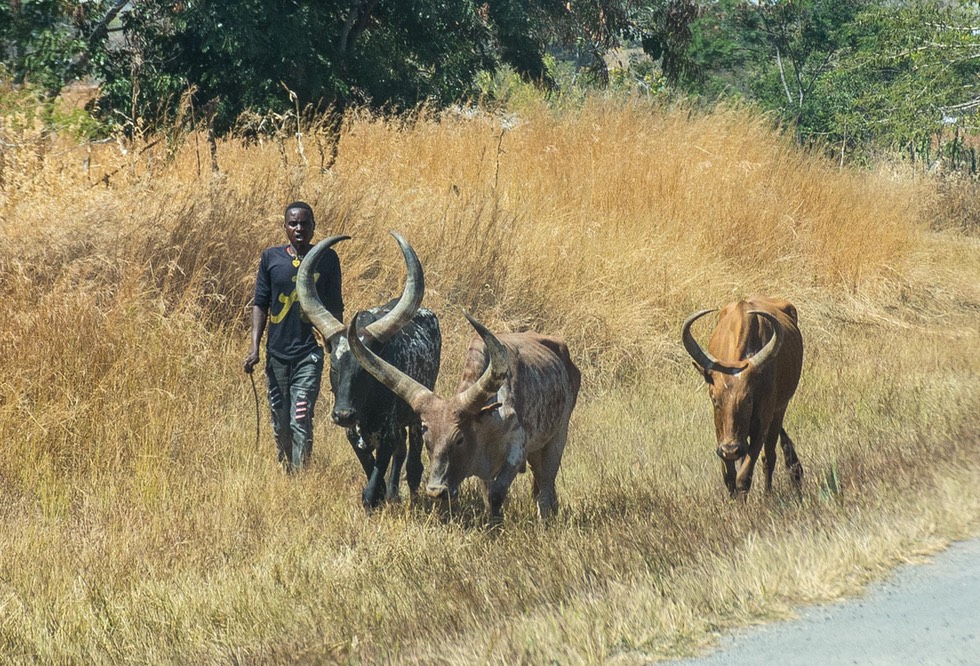
Our first stop south of Mbeya, heading towards the Malawi border, involved quite an adventure. We headed up into the mountains, then took a rocky road on a trek into the back side of Kitulo NP, which us most famous for its wild orchids — but that’s later in the year. Driving through the countryside there were small groups of cows being herded along the road, and these — a new breed for us — had the most humungous horns we’d ever seen; they put Texas longhorns to shame.
On iOverlander we had found what looked like a really lovely wild camp spot up in the mountains, at about 8700 feet (2750 meters). It proved to be a more difficult road than we’d hoped, but through beautiful countryside. We passed through several small villages, exchanging waves and smiles with the residents as we slowly and gently moved along, finally settling in a small meadow on a saddle with a great view looking out on the highlands. We even had a few stray wildflowers, despite it being mid-winter.
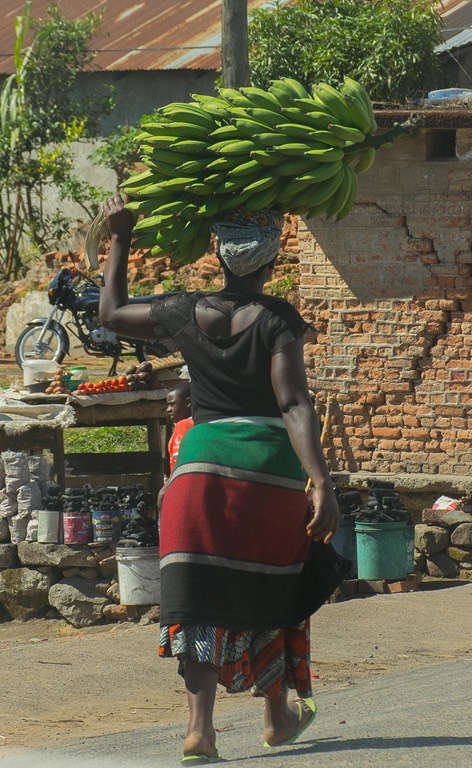
We had the place to ourselves except for one group of cows and another of goats, together with their young minders. The kids would come by 2-3 times during the day, sit on the grass and watch us while their charges munched their way across the open meadow, then move on. They were no bother, and they seemed to think we were pretty interesting. The cows seemed to be convinced that the absolute best grass on the entire hill was just outside our door, and that our doorstep was a good scratching spot, so they stayed pretty close.
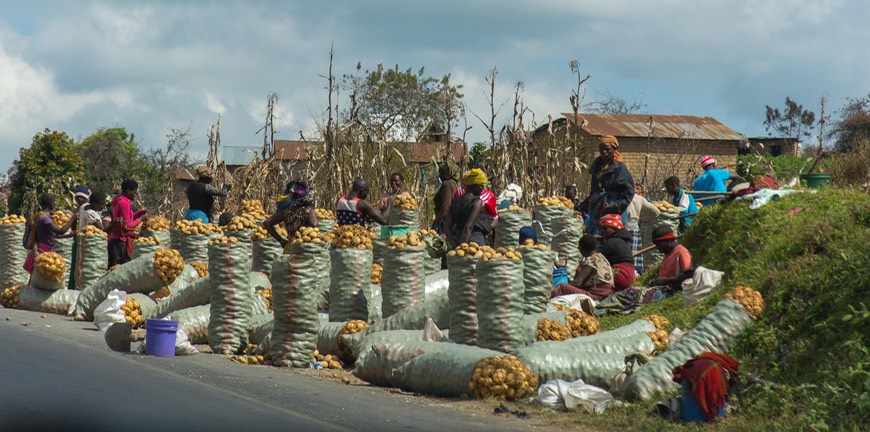
After two cool but lovely nights, we drove back down the difficult road (14 kms in about an hour and a quarter) to reach the paved highway that would take us south toward the border. We enjoyed the mountains. There are lakes here, mostly craters from the area’s volcanic past. In some ways it reminded us of mountainous Colorado.
Much of the area is partly forested and in the villages the housing was often made out of wood, even including some log cabins. Before now most of what we have seen in Africa is either dusty kraals or mud huts, so this was an interesting change. There was plenty of small village life and we made room for the truck drivers and motorbikes who waved and smiled as they squeezed past us. There’s plenty of traffic on that road; it’s the “highway” across these mountains to get to areas further east. Goods are being transported, but also those bikes most times have one or two passengers. Much better than walking! It’s a lovely area.
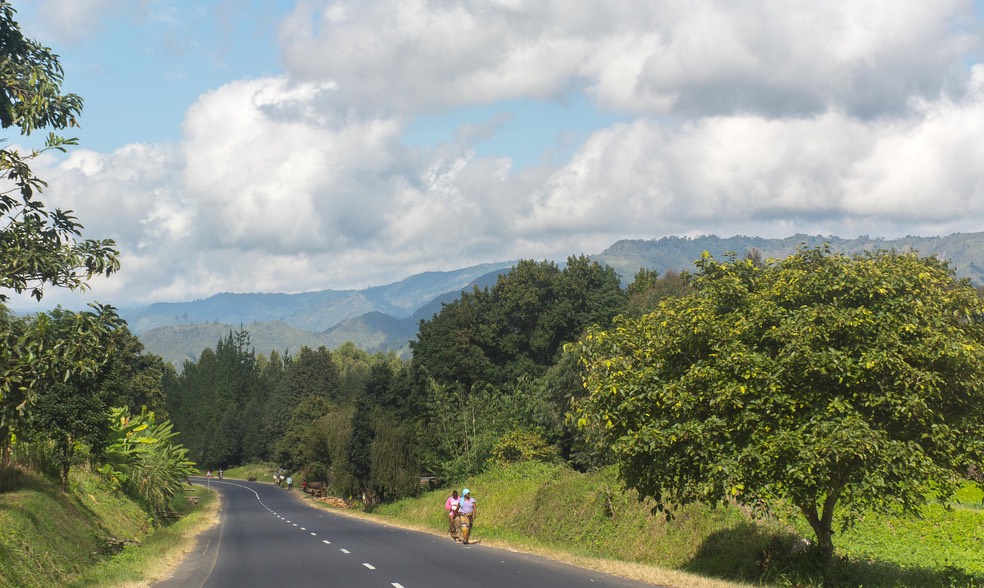
Once we’d dropped back down to meet the highway south, the road was excellent, in near new condition. We continued to lose elevation, and watched the land around us slowly change. There were fewer coffee bushes, and often the ones we did see were now being shaded by the banana trees, which had become ubiquitous. And now these were joined by lovely tea plantations. People were hauling bunches of bananas around by hand, in trucks, on bicycles, all kinds of ways; drying grain on the shoulders of the highway; and as always carrying all sorts of things either on various wheeled vehicles or on their heads.
We may have only seen a small corner of Tanzania, but we think we chose the very best part. People were a constant, and they came in all sizes and shapes, with varying activities on their minds. Gathering firewood was a regular goal; we often saw women (and men) balancing large logs on their heads as they walked along, dodging traffic and ruts in the road. Heading out to work the land always seems to require walking a long distance, carrying hoe or spade over your shoulder; the women mostly had babies riding on their backs in addition to their working load. On the weekends, whole families would be out along the road, enjoying the weather or heading off to visit with friends, or taking food to market regardless of the day of the week. Since all our travel was along the highways, we saw it all.
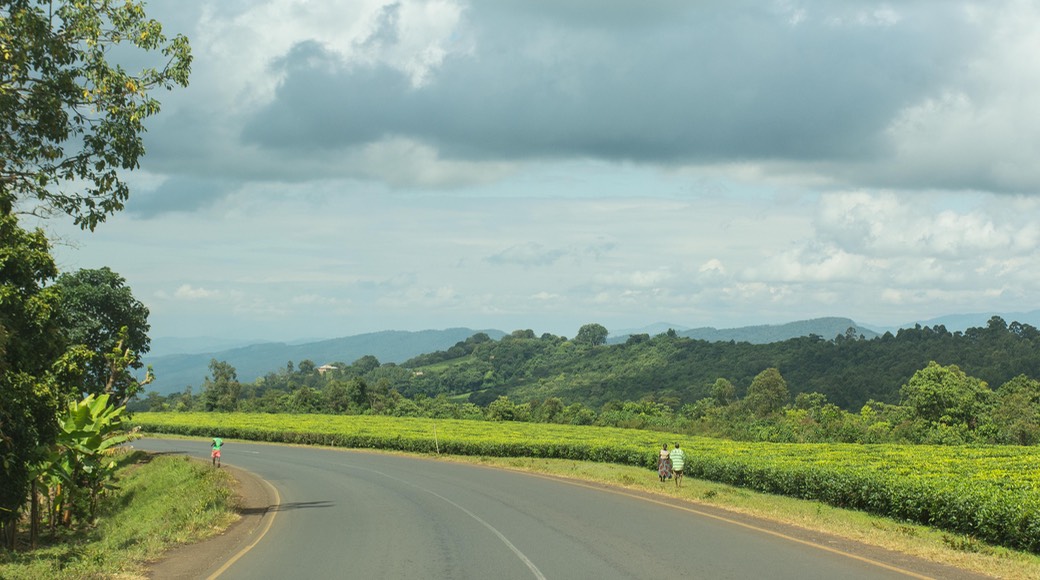
In other countries, walking or riding a bicycle was the usual; here in Tanzania we saw plenty of motorbikes used for all sorts of things. What always made us laugh the most was when riding on the back was a pig or a goat or once even a calf — either dead or about to be. Unfortunately we never saw them quickly enough to grab a photo, so we can’t share the sight with you.
We spent our last night in country at a small, lovely home at 539 meters in elevation, not far from the border. We are finding that this is a very typical overnight spot in this part of the world. There was a grassy area for parking, with plenty of trees, a welcoming owner to answer our questions, and a quiet night for us before starting toward the border crossing into Malawi. There were many flowers in bloom in the garden, and the aroma wafting along the warm evening breezes was a delight. A simple spot, it was a nice ending for our time in our little part of Tanzania. The next morning, off we went to do battle with the local Border Bastards yet again. All was well with Team Tortuga.
Ever intrepid (sort of), we sign off once again, wishing you well.
Rick, Kathy and La Tortuga
See more from Tanzania on the photo page for this story